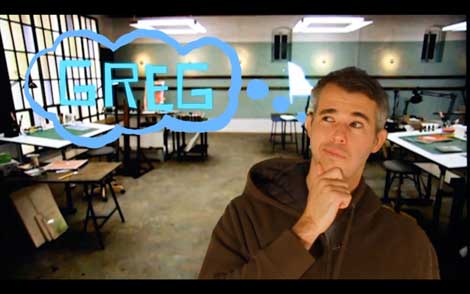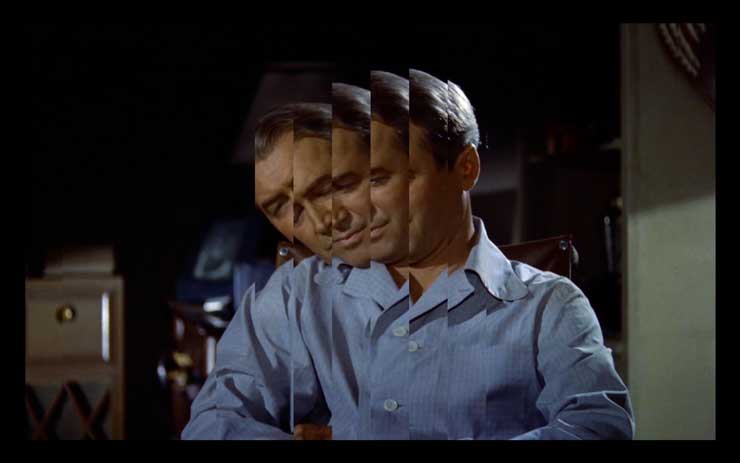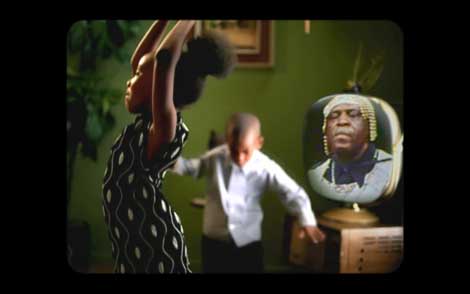As I may have mentioned before, collage—in spite of lip service to artists from Picasso/Braque to Hannah Hoch to Rauschenberg to Elliott Hundley—remains under-acknowledged as the central formal and conceptual engine of modernist and postmodern art over the last 100 years. And that’s just talking about the visual art version of the collage technique.
Avant-garde musique concrete composition and hip-hop sampling are both based on the juxtaposition of appropriated fragments of the pre-existing soundscape, and 20th century experimental and popular literary forms also reflect a deep grounding in the cut-up aesthetic. It’s everywhere, perhaps even responsible for neurologically rewiring human consciousness.
But there is no medium where collage has been as seamless a fit and had such a profound an impact as cinema. The very language of filmmaking is rooted in the juxtaposition of disconnected images, and the human ability to forge links between them—on a literal physiological level as well as the seminal montage theory of Lev Kuleshov and Sergei Eisenstein. Many of the most innovative visual artists of the 20th century were also noted collage filmmakers—Joseph Cornell’s Rose Hobart (1936), Bruce Conner’s A Movie (1958) and Christian Marclay’s The Clock (2010) are routinely cited as landmarks in the history of film.
Experimental filmmakers whose work explicitly encompasses collage include luminaries such as Stan Brakhage, Chris Marker and Harry Smith as well as more obscure legends like Arthur Lipsett, Craig Baldwin, and Michael Bay, whose groundbreaking Transformers sequence (2007 – ∞) is, in fact, made from the same five minutes of CGI footage, randomly reconfigured according to the movements of a termite colony in Botswana.
With the Internet, the motion picture collage genre has exploded in gazillion directions, from endless satirical hacks of the Hitler-in-the-bunker scene from Downfall (2004) to Henry Hanrahan’s Hit by a Bus supercut (2013) to thepiratecinema.com, which creates an theoretically infinite found footage collage by compiling fragments of live torrents. The structure of web itself can be understood as a digital manifestation of the Modernist attention deficit quantum consciousness launched by collage media a century ago.

Falling in Love…with Chris and Greg: Work of Art! Reality TV Special, Chris E. Vargas and Greg Youmans (US, 2012)
What this all boils down to is the fact that mash-ups are the medium of today! Conceptually and formally, collage shapes every aspect of contemporary culture, from mainstream political campaigns to amateur avant-garde auteurs making shot-by-shot recreations of montage sequence from Footloose (1984) and layering it over the original. The extent of the latter can be glimpsed in the breadth of exciting and idiosyncratic work on display at the annual Festival of (In)Appropriation, a touring showcase curated by Jaimie Baron, Lauren Berliner and Greg Cohen (replacing Andrew Hall)—nurtured and hosted locally by Los Angeles Filmforum.
The Fo(I)A is now in its seventh year, and continuing to expand. So many submissions are received that this year’s program has been split into two—one debuting Feb 15 at The Egyptian in Hollywood, the other scheduled for October. The Fo(I)A’s claim to irreverence is born out in the first film screened in the first festival (also the first included on the five DVD compilations recently been compiled from previous festivals, available through their website)—Khan (excerpt 2008) by Daniel Martinico, featuring straight-up bootleg slivers of William Shatner as Captain Kirk, frozen in glitchy spittle-flecked mid-gesticulation and intermittently thawed out to scream his arch-nemesis’ name.
Fo(I)A 7 starts with a more elaborate bang. Astro Black: Race for Space by Australian team Soda_Jerk, who sample from nearly two dozen movies to reveal the ultimate moon-landing conspiracy—Sun Ra was already there! It is a dream of the America that could have been. Other stabs at what the swells call détournement include gay art pranksters Chris and Greg inserting themselves into an episode of Work of Art, and a funky but disturbing collection of every scene from Seinfeld in which nothing happens, assembled by LJ Frezza. Having never sat through an episode of either, I’m no expert—but I’m willing to bet that these canny distillations are both deeper and funnier than their source materials.
While such purposeful deconstructions of mass media are undoubtedly the most popular form of collage film, other strategies yield equally potent results. Brian L. Frye’s Sara Nokomis Weir (2014) tinkers with a form of video scrapbook called a “victim impact video”—a courtroom tool designed in this case to persuade a jury of the preciousness and lost potential of the titular 19 year-old’s life. Frye has overdubbed the mother’s original deadpan narration and borrowed Enya soundtrack with the California Supreme Court hearing of arguments made after serial rapist Douglas Oliver Kelly—who had stabbed Weir 29 times with a pair of scissors—appealed on the basis that the video was prejudicial. That’s one big can of appropriationist worms!
Still, the most arresting works for me are relatively formalist—John Davis’ Demolished Every Second (2014)—a throbbing pastiche of B&W Soviet film leader; My clothes were dragging me back (2010) in which Swedish Maria Magnusson poetically conjoins a British radio broadcast of people recalling dreams with images of Canadian children involved in some sort of pedagogical experiment; or the always-reliable Gregg Biermann who continues his exquisite algorithmic slice-and-dice reconfigurations of iconic Hollywood cinema (previous subjects include The Wizard of Oz, North by Northwest and The Lady From Shanghai) with Iterations, a vertical Venetian-blind disordering of Rear Window, which focuses a laser-like attention on the details of Hitchcock’s craftsmanship, while simultaneously forging something entirely strange and beautiful. Which is why recycling old culture never gets old itself; however you slice it, you always expose something raw and new.
http://festivalofinappropriation.org/
Festival of (In)appropriation #7
a festival of experimental found footage films
7:30 pm, February 15, 2015
Los Angeles Filmforum, Los Angeles, CA
Spielberg Theater, Egyptian Theater in Hollywood




